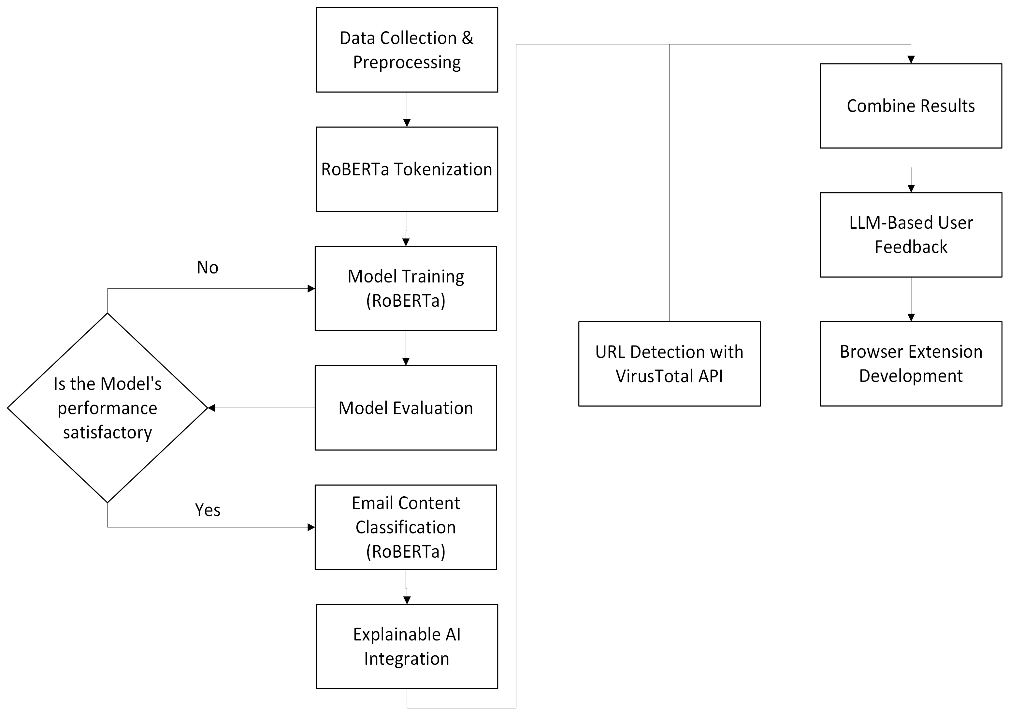An AI-Powered Browser Extension Using Roberta and XAI for Phishing Email Detection and Security Awareness
Keywords:
Phishing Detection, Cybersecurity Awareness, RoBERTa, Explanable AI, Deep LearningAbstract
Phishing attacks are a common and serious cybersecurity threat today. They exploit human weaknesses by stealing sensitive information by sending fake emails and harmful links. Traditional email filtering systems like rule-based methods and black-box models, struggle to detect phishing. Rule-based filters fail when attackers use new tricks, and black-box models lack transparency, which limits user awareness.
This work introduces a smart browser extension that uses deep learning and Explainable AI (XAI) for phishing detection. We use a transformer-based model, Roberta, trained on a large email dataset, achieving 98.12% accuracy in classifying email content. For checking URLs, we use VirusTotal, which gathers threat intelligence from multiple sources. We also apply XAI tools to highlight key parts of the text that contributed to the classification of the email content, and a large language model (LLM) to provide simple explanations about phishing.
Our hybrid approach combines explainable deep learning with multi-source URL verification. This helps users understand phishing threats better and improves their ability to spot attacks on their own.
References
O. K. Sahingoz, E. Buber, O. Demir, and B. Diri, “Machine learning based phishing detection from URLs,” Expert Syst. Appl., vol. 117, pp. 345–357, Mar. 2019, doi: 10.1016/J.ESWA.2018.09.029.
P. H. Kyaw, J. Gutierrez, and A. Ghobakhlou, “A Systematic Review of Deep Learning Techniques for Phishing Email Detection,” Electronics, vol. 13, no. 19, p. 3823, Sep. 2024, doi: 10.3390/ELECTRONICS13193823.
N. Q. Do, A. Selamat, O. Krejcar, E. Herrera-Viedma, and H. Fujita, “Deep Learning for Phishing Detection: Taxonomy, Current Challenges and Future Directions,” IEEE Access, vol. 10, pp. 36429–36463, 2022, doi: 10.1109/ACCESS.2022.3151903.
P. Prakash, M. Kumar, R. Rao Kompella, and M. Gupta, “PhishNet: Predictive blacklisting to detect phishing attacks,” Proc. - IEEE INFOCOM, 2010, doi: 10.1109/INFCOM.2010.5462216.
S. Abu-Nimeh, D. Nappa, X. Wang, and S. Nair, “A comparison of machine learning techniques for phishing detection,” ACM Int. Conf. Proceeding Ser., vol. 269, pp. 60–69, 2007, doi: 10.1145/1299015.1299021.
J. Rashid, T. Mahmood, M. W. Nisar, and T. Nazir, “Phishing Detection Using Machine Learning Technique,” Proc. - 2020 1st Int. Conf. Smart Syst. Emerg. Technol. SMART-TECH 2020, pp. 43–46, Nov. 2020, doi: 10.1109/SMART-TECH49988.2020.00026.
Z. Alshingiti, R. Alaqel, J. Al-Muhtadi, Q. E. U. Haq, K. Saleem, and M. H. Faheem, “A Deep Learning-Based Phishing Detection System Using CNN, LSTM, and LSTM-CNN,” Electronics, vol. 12, no. 1, pp. 232–232, Jan. 2023, doi: 10.3390/ELECTRONICS12010232.
F. S. Alsubaei, A. A. Almazroi, and N. Ayub, “Enhancing Phishing Detection: A Novel Hybrid Deep Learning Framework for Cybercrime Forensics,” IEEE Access, vol. 12, pp. 8373–8389, 2024, doi: 10.1109/ACCESS.2024.3351946.
V. L. and C. S. N. Capuano, G. Fenza, “Explainable Artificial Intelligence in CyberSecurity: A Survey,” IEEE Access, vol. 10, pp. 93575–93600, 2022, doi: 10.1109/ACCESS.2022.3204171.
T. Koide, N. Fukushi, H. Nakano, and D. Chiba, “ChatSpamDetector: Leveraging Large Language Models for Effective Phishing Email Detection,” Feb. 2024, Accessed: Apr. 20, 2025. [Online]. Available: https://arxiv.org/abs/2402.18093v2
R. Meléndez, M. Ptaszynski, and F. Masui, “Comparative Investigation of Traditional Machine-Learning Models and Transformer Models for Phishing Email Detection,” Electron. 2024, Vol. 13, Page 4877, vol. 13, no. 24, p. 4877, Dec. 2024, doi: 10.3390/ELECTRONICS13244877.
S. Jamal, H. Wimmer, and I. H. Sarker, “An Improved Transformer-based Model for Detecting Phishing, Spam, and Ham: A Large Language Model Approach,” Nov. 2023, Accessed: Apr. 20, 2025. [Online]. Available: https://arxiv.org/abs/2311.04913v2
H. Baniecki and P. Biecek, “Adversarial attacks and defenses in explainable artificial intelligence: A survey,” Inf. Fusion, vol. 107, p. 102303, Jul. 2024, doi: 10.1016/J.INFFUS.2024.102303.
K. Patil and S. R. Arra, “Detection of Phishing and User Awareness Training in Information Security: A Systematic Literature Review,” Proc. 2nd Int. Conf. Innov. Pract. Technol. Manag. ICIPTM 2022, pp. 780–786, 2022, doi: 10.1109/ICIPTM54933.2022.9753912.
S. Chakraborty, “Phishing email detection,” Kaggle, 2023.

Downloads
Published
How to Cite
Issue
Section
License
Copyright (c) 2025 50sea

This work is licensed under a Creative Commons Attribution 4.0 International License.




















